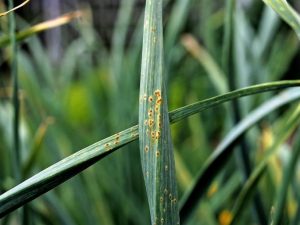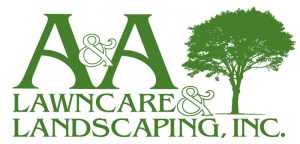
More About Fungal Rust
The substance that forms on your grass and plants is not actual rust, but the substance that does result from the disease does look like rust. Rust fungus appears as a brown rusty coating or spotting on your grass, and the spores will be orange-brown raised bumps on the undersides of the blades of grass. It is best to spot rust early on and treat it before it becomes too serious. The rust will even come off on your hands in a powdery orange form, in the same way that rust does
Recognizing “Rust “ On Your Lawn
Grass rust identification can be done by pulling a couple of blades out of the turf. The blades will be coated with orange-red to yellowish brown dust or spores. The lawn rust begins with yellowing leaf blades and small yellowish spots which mature to orange, red or brown coloring. The spores can be rubbed off the grass blades with a finger. Overall, patches of the grass will become thin and weak. Fine, dark-colored grasses such as ryegrass, bluegrass and fine fescue are more susceptible to rust disease that other types of grass.
Helping Your Lawn to Reject Rust Disease
Cultural disease control practices create favorable conditions for a healthy lawn, and often create unfavorable conditions for the growth of Rust. Environmental conditions cannot be changed but cultural practices performed can be modified to lessen the chance of extensive damage from Rust.
- Mix Up Your Seeds – seeding your lawn with a variety of grass types will help discourage rust disease, as it prefers darker, more delicate grass types and spreads easily within the entire lawn is composed of grasses like ryegrass, bluegrass or tall fescue only.
- Mow Regularly – Follow good mowing practices, including keeping the mower blades sharp and mowing your lawn to the correct height. Scalped lawns are much more vulnerable to fungal disease. If your lawn has diseased patches, be sure to wash and disinfect the underside of your mower after each use. Mowing regularly clips off diseased grass and encourages new, rust-free grass to grow
- Fertilize – Fertilizing your grass will keep it growing quickly and give rust disease less time to spread.
- Use Fungicides – If all else fails, look for a fungicide (preferably organic) that’s rated specifically for rust disease. Fungicides won’t help your grass regrow, but they’ll get the fungal spores in check so that your improved lawn care practices can take effect. When dealing with rust disease you probably need to apply fungicides more than once.
- Pick Up After Mowing – Do not leave the clippings after you mow , on the lawn. Picking up grass clippings will remove fungal spores from grass that is already infected and keep them from spreading to other areas.
You could try to keep a healthy lawn yourself
-or-
You could call the pros at A & A Lawn Care & Landscaping to help you do it right the first time! We help our residential and commercial clients with their lawns and landscaping everyday!
Contact Us (859-384-0266) for a Free Consultation!
—
 About A & A Lawn Care & Landscaping
About A & A Lawn Care & Landscaping
A & A Lawn Care & Landscaping can beautify your lawn and landscaping using our vast experience in turf grass management. Our complete lawn service is designed for both residential and commercial lawns and we keep your lawn healthy without harming your family, staff, or pets.
A & A Lawn Care & Landscaping’s Lawn Care Program
>> Learn More <<

 About A & A Lawn Care & Landscaping
About A & A Lawn Care & Landscaping